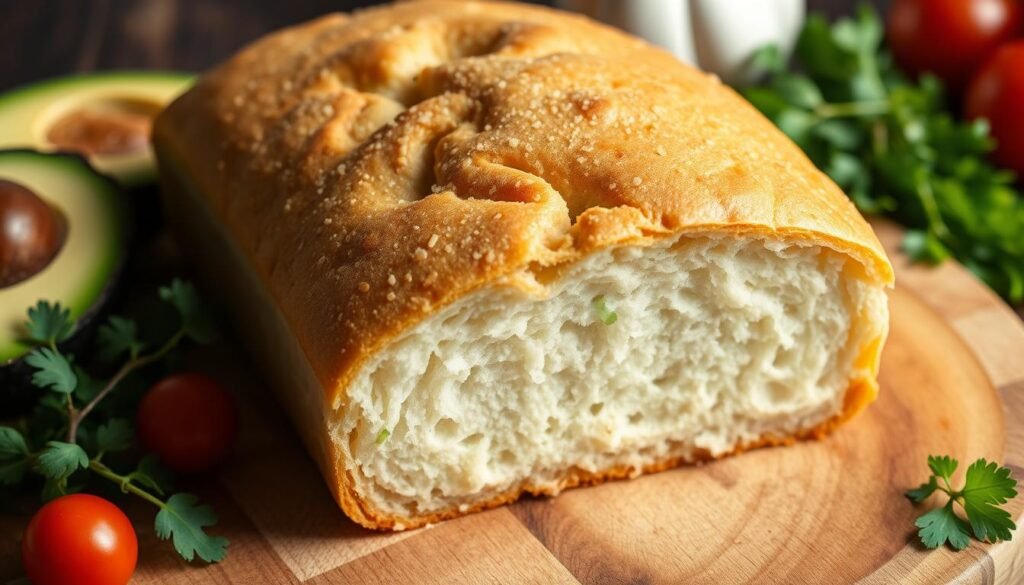One of the things I’ve always loved about Keto is how flexible it can be. It’s not about giving up the things you love—it’s about finding substitutes that work for your goals while still letting you enjoy your favorite flavors. Bread has always been one of those things for me. I used to think going low-carb meant saying goodbye to freshly baked bread forever, but with Keto, I’ve found so many incredible alternatives. Whether I’m maintaining my weight or focusing on losing a few pounds, these substitutes make all the difference, and I honestly couldn’t be happier with how they fit into my lifestyle.
If you’ve ever craved the taste of soft, freshly baked bread but worried about the carbs, you’re in the right place! Keto bread recipes are a total game-changer. They let you satisfy those cravings without derailing your diet or feeling deprived.
This guide will take you on a journey through seven amazing Keto bread recipes that I’ve come to love. From soft sandwich loaves perfect for your favorite deli meats to chewy bagels and even flaky biscuits, there’s something here for every bread lover. These low-carb baking recipes aren’t just delicious—they’re practical, satisfying, and perfect for sticking to a carb-conscious lifestyle.
With these recipes, you don’t have to miss out on the joy of bread. Keto has made it possible to enjoy those familiar comforts while staying on track, and I can’t wait to share these with you!
Key Takeaways
- Discover a variety of delicious keto bread recipes that cater to your cravings
- Learn the essential techniques and ingredients for successful low-carb baking
- Enjoy your favorite carb-laden baked goods without compromising your keto lifestyle
- Explore creative flavor variations and serving suggestions to enhance your keto bread experience
- Troubleshoot common keto bread baking challenges with expert tips and solutions
Ready to improve your keto baking skills and enjoy delicious low-carb bread? Let’s start and find out how to satisfy your cravings with each keto-friendly bite.
Understanding the Basics of Keto-Friendly Bread Making
Starting a keto diet means finding new ways to enjoy bread without carbs. Making tasty keto bread is all about knowing the basics of keto baking.
Essential Low-Carb Flour Alternatives
Wheat flour is a no-go on keto, but there are great low carb flour alternatives. Almond flour, coconut flour, and psyllium husk powder are popular choices. They each bring their own texture and nutrition to keto bread. Trying out these flours is essential for the perfect keto bread.
Key Binding Agents for Keto Breads
- Eggs: Eggs are a natural binder, helping keto breads rise and have structure.
- Xanthan gum: This ingredient improves texture and prevents crumbling in keto breads.
- Psyllium husk: It’s not just a flour; it also adds chewiness and binding to keto breads.
Important Temperature Considerations
Getting the temperature right is key to perfect keto bread. Make sure the dough is at the right temperature. Keep the oven temperature steady. And let the bread cool down properly. These steps are crucial for mastering keto bread baking.

“The key to successful keto bread baking is understanding the unique properties of low-carb ingredients and how they interact during the baking process.”
Must-Have Ingredients for Perfect Keto Bread Recipes
Baking keto-friendly bread needs the right ingredients. Start your low-carb baking journey with the key keto bread ingredients and low carb baking essentials. They ensure your bread turns out perfect in texture and taste.
Begin with low-carb flours as the base of your keto bread. Almond flour, coconut flour, and psyllium husk powder are great. They offer structure without the carbs found in regular wheat flour.
For binding, use eggs, nut butters, and healthy fats like coconut or avocado oil. These add moisture and help your bread keep its shape.
- Eggs: Provide structure and richness
- Nut butters: Lend creaminess and binding power
- Coconut oil or avocado oil: Healthy fats that enhance texture
Remember the leavening agents – baking powder and baking soda. They make your keto bread light and airy. Also, xanthan gum or psyllium husk can improve structure and chewiness.
With these keto bread ingredients and low carb baking essentials, you’re set. You’ll make delicious keto bread that’s guilt-free and satisfying.

Fluffy Low Carb Sandwich Bread: Your Daily Staple
Making the perfect low-carb sandwich bread is a big win for keto fans. It’s a staple that lets you enjoy hearty, fluffy slices with your favorite fillings. With a few easy tips, you can make it as soft and airy as regular bread, but without the carbs.
Tips for Achieving the Perfect Rise
The secret to fluffy low-carb sandwich bread is in the proofing. Be patient and let the dough rise well before baking. Use keto-friendly flours and agents like psyllium husk or xanthan gum to keep it shaped. Also, keep your kitchen’s temperature and humidity right for the yeast to work best.
Storage and Freshness Guidelines
- Keep your freshly baked low-carb sandwich bread in an airtight container at room temperature for up to 5 days.
- To keep it longer, slice the bread and freeze it in resealable bags. Thaw at room temperature or in the microwave when you’re ready to eat.
- Don’t store keto bread in the fridge, as it can get stale fast in the cold, dry air.
Serving Suggestions
Low-carb sandwich bread is great for many meals and snacks. Try it toasted for a breakfast sandwich, as the base for avocado toast, or as a side for soups and stews. It’s also good with sweet toppings like nut butters and low-sugar jams.

With these tips, you can enjoy fluffy, satisfying low-carb sandwich bread every day. It’s perfect for lunches or quick snacks. This staple will be your favorite for all your bread cravings.
Chewy Keto Bagels That Rival the Real Thing
For those who love keto-friendly breakfasts, finding the perfect low carb bagels is now easy. This recipe makes delicious, chewy keto bagels that taste just like the real thing.
To get that chewy texture, use low-carb flours and special baking tricks. Mix almond flour, coconut flour, and psyllium husk to make a dough that feels like a real bagel.
- Start by mixing the dry ingredients like almond flour, coconut flour, and psyllium husk. This makes a strong base.
- Then, add the wet ingredients like eggs, cream cheese, and baking powder. This makes the dough soft but firm.
- Shape the dough into bagel rounds with a hole in the middle for the classic look.
- Bake the bagels at the right temperature and time. This makes them golden brown on the outside and chewy inside.
After baking, you get Low carb bagels that are perfect for breakfast. Top them with cream cheese, avocado, or Everything Bagel seasoning for a delicious keto-friendly breakfast.
“These keto bagels are a game-changer for my morning routine. They taste just like the real thing, but without the guilt.”
Golden Brown Keto Biscuits: Southern Comfort Made Low-Carb
Keto fans looking for Southern comfort will love golden brown keto biscuits. These biscuits bring the taste of classic Southern baking to your plate. They’re low in carbs but full of flavor.
Texture Secrets for Flaky Biscuits
Getting the right texture in keto biscuits is all about the mix of ingredients and how you bake them. Use almond flour and coconut flour for a light, flaky inside. A golden-brown outside comes from the right temperature and baking time.
Flavor Variations to Try
There’s more to keto biscuits than just the plain kind. Add shredded cheddar cheese for a savory taste. Mix in fresh chives and crumbled bacon for a Southern twist. For sweetness, add a bit of stevia or erythritol.
Serving and Pairing Ideas
Low carb biscuits are great with many keto dishes. They’re perfect as a side to creamy chicken and mushroom casserole. Or, enjoy them for breakfast with sugar-free jam or cinnamon and erythritol.
Enjoy the taste of the South with these golden brown, flaky keto biscuits. They’re perfect for anyone on a low-carb diet. Whether you’re new to keto baking or a pro, these biscuits are a must-try.
Light and Airy Low Carb Dinner Rolls
Craving a warm, fluffy dinner roll for your keto meal? Our low carb dinner rolls are perfect. They’re light and airy, great with any keto dish, like juicy roasts or hearty soups.
Our rolls are made with low-carb flours and special binders. They taste great and have the right texture, without the carbs. Enjoy them with your keto meal or on their own. They’ll be a favorite in your keto kitchen.
Key Ingredients for Keto-Friendly Dinner Rolls
- Almond flour: Provides a nutty flavor and tender crumb
- Coconut flour: Adds moisture and structure
- Psyllium husk: Acts as a key binding agent
- Eggs: Create a light, airy texture
- Butter or ghee: Adds richness and a delightful mouthfeel
Baking Tips for Perfect Keto Dinner Rolls
- Measure and mix dry ingredients carefully for the right flour and binder balance.
- Fold in wet ingredients gently to avoid overworking the dough.
- Bake at 375°F to prevent overbrowning and keep the inside soft and fluffy.
- Watch the rolls closely while baking and adjust time as needed for the right doneness.
With practice and these tips, you’ll make warm, low carb rolls that are perfect with your keto meals. Enjoy homemade bread’s comforting taste without the guilt.
Troubleshooting Common Keto Bread Baking Issues
Baking keto-friendly breads can be a fun journey, but it comes with its own set of challenges. You might face issues with texture, flavor, or temperature. We’re here to help you tackle these problems and get your bread to taste like it came from a bakery.
Addressing Texture Problems
If your keto bread feels too dense or gummy, it might be due to an unbalanced flour mix. Try mixing different types of low-carb flours like almond, coconut, and psyllium husk. Also, avoid overmixing the dough to prevent a tough texture.
Fixing Flavor Concerns
Keto bread can sometimes taste flat. To enhance the flavor, add a bit of salt, a touch of sweetener, or some herbs and spices. Experiment with different flours to find one that suits your taste. Remember, taste as you go and adjust until it’s just right.
Temperature and Timing Solutions
- Make sure your oven is at the right temperature before baking.
- Watch the bread closely while it bakes, as keto flours can burn easily.
- If the outside is browning too fast but the inside is still raw, cover it with foil to prevent overcooking.
- Adjust the baking time if needed, as keto bread might take longer to cook through.
By tackling these common keto baking tips and low carb bread troubleshooting issues, you’ll get better at baking keto bread. Keep trying new things and don’t be afraid to tweak your recipe until it’s just right for you.
Kitchen Tools and Equipment for Successful Keto Baking
Starting your keto bread baking journey needs the right keto baking equipment and low carb kitchen essentials. These tools help you make delicious keto breads. They also keep you on track with your diet.
Here are the must-haves for your keto-friendly kitchen:
- High-quality baking sheets or pans: Choose sturdy, heavy-duty ones for even heat.
- Silicone baking mats or parchment paper: They prevent sticking and make cleaning up easy.
- Digital kitchen scale: A reliable scale is crucial for precise measurements of low-carb flours.
- Mixing bowls and utensils: Get sturdy, non-reactive ones for keto doughs.
- Stand mixer or hand mixer: These tools make mixing and kneading easier.
- Bread loaf pans or biscuit cutters: They help you get the right shape and size for your keto breads.
- Oven thermometer: It’s important to check your oven’s temperature for baking success.
With these keto baking equipment and low carb kitchen essentials, you’re ready to make tasty keto breads. You’ll be on your way to becoming a keto bread-baking pro.
“The right tools can make all the difference in your keto baking journey. Invest in quality equipment, and you’ll be rewarded with consistently amazing results.”
Conclusion: Mastering Your Keto Bread Journey
Starting your keto bread baking journey is exciting. Try out different keto bread recipes to find what you like best. Feel free to change them to match your taste. Soon, you’ll make tasty low-carb breads that meet your diet needs.
To succeed in low carb baking, learn about keto-friendly ingredients. Practice to get the right texture and rise. Keep an eye on your recipes and adjust as needed. Before you know it, you’ll be making amazing keto bread that wows everyone.
Baking is more than just making food; it’s a fun journey. Enjoy the ups and downs, and always have fun. With each loaf, you’ll get better and discover new tasty low-carb options. Now, dive into your keto bread adventure with excitement and determination.






